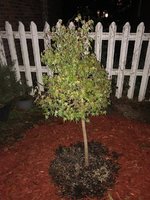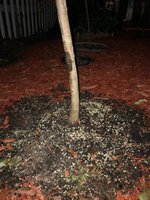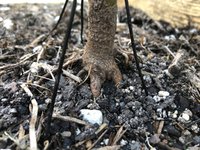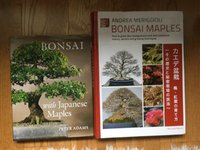A basic bonsai development formula appears to be allow the trunk to grow to desired thickness, cut to 1/3 of the anticipated size of tree and grow a new leader. The maples I have that should be ready for their first chop this spring are stick straight, aside from the angle at which they grow out of the ground. I assume that in order to introduce movement lower down on the trunk I would need to cut lower down on the trunk - lower than 1/3 of the size of the tree. Is it better to trunk chop when the trunk is much smaller to introduce movement early on and allow the tree to grow wild to build the trunk size, or first let it grow to the desired thickness and only then cut down lower than 1/3? Does this make a difference in the speed of development, scar healing, type of movement introduced, etc.?
You are using an out of date browser. It may not display this or other websites correctly.
You should upgrade or use an alternative browser.
You should upgrade or use an alternative browser.
Trunk Movement, Taper & Proportion
- Thread starter dbonsaiw
- Start date
PA_Penjing
Chumono
If you want to stay formulaic with it, just cut it down to 1/4 of the intended height. Then you get an extra chop in. Is this terrible advice? I'm really asking. I chop or "drastic prune" where I need to, to make sure the trunk isn't a boring rail, but it's such a long process I haven't "finished" a tree from seed or seedling
sorce
Nonsense Rascal
Can't really have a formula without all the necessary information.
The lacking information is....
How many segments of taper will you have?
Everything makes a difference, but more importantly, an exact and calculatable difference every time, it's just we have to many variables to see it.
Minimizing the variables, and understanding which ones are at play, becomes quite easy when you work With the tree, rather than forcing something upon it.
Most variables are present only because we do not replicate our care patterns.
Sorce
The lacking information is....
How many segments of taper will you have?
Does this make a difference
Everything makes a difference, but more importantly, an exact and calculatable difference every time, it's just we have to many variables to see it.
Minimizing the variables, and understanding which ones are at play, becomes quite easy when you work With the tree, rather than forcing something upon it.
Most variables are present only because we do not replicate our care patterns.
Sorce
River's Edge
Masterpiece
Introduction of movement can be by chopping and growing a new leader with change of direction or it can be by wiring young growth in a change of direction. So it does not necessarily mean a low chop in Bonsai development.A basic bonsai development formula appears to be allow the trunk to grow to desired thickness, cut to 1/3 of the anticipated size of tree and grow a new leader. The maples I have that should be ready for their first chop this spring are stick straight, aside from the angle at which they grow out of the ground. I assume that in order to introduce movement lower down on the trunk I would need to cut lower down on the trunk - lower than 1/3 of the size of the tree. Is it better to trunk chop when the trunk is much smaller to introduce movement early on and allow the tree to grow wild to build the trunk size, or first let it grow to the desired thickness and only then cut down lower than 1/3? Does this make a difference in the speed of development, scar healing, type of movement introduced, etc.?
Taper can be introduced by chop with growing new leader, or selecting branch to replace the trunk, this also introduces a change of direction.
Proportion is where the formulae changes. It will depend on the overall size of the finished tree.
When you are quoting fractions it is easily misinterpreted unless stated with a high degree of specificity.
Do you mean 1/3 distance of overall trunk to the first branch? or do you mean introducing movement at that point?
It is probably best to understand that the best process or formulae will fit the style of development and not be a standard approach for bonsai development.
For example you first sentence might apply for a broom style, however in many other styles introducing movement and taper would be best done lower than that. It is often stated that movement should be introduced as low to the base as possible and taper should be gradual not introduced at a specific ratio.
Another key understanding is that growing processes reflect the bias of the developer for particular styles and outcomes. Expect to find a wide variety of formulae and or techniques.
You might receive more specific suggestions if you posted a picture of a tree you wish to work with and gave a general idea of the style you have in mind. This would assist all concerned as the techniques and approaches vary with species and stage of development the tree is at.
Good questions indeed and I may have a chicken and egg issue. Trunk diameter on one of them is just over 2.1" above the root flare. I was thinking about cutting it at around 7" or so (there's a node at 7" and 5" with nothing apparent in between). This was based on 3 or so cuts. As I think about it, do I really want 7" of straight trunk? Probably not. I could cut it much lower and then cut every year or so (depending on leader diameter). Getting the second leader to the right size will take some time.
River's Edge
Masterpiece
Is this an elephant trunk, conifer, deciduous or steamer trunkGood questions indeed and I may have a chicken and egg issue. Trunk diameter on one of them is just over 2.1" above the root flare. I was thinking about cutting it at around 7" or so (there's a node at 7" and 5" with nothing apparent in between). This was based on 3 or so cuts. As I think about it, do I really want 7" of straight trunk? Probably not. I could cut it much lower and then cut every year or so (depending on leader diameter). Getting the second leader to the right size will take some time.
Pictures please along with identification of the species.
Thank you
River's Edge
Masterpiece
Thank you, now that I am aware of the material you have in mind and the fact that they are in the ground.
A couple of suggestions.
1. Consider strengthening the trees with fertilization and extra care this coming spring before any steps are taken. This is dependant on when they were planted in the ground. Where they recently transplanted or have they been in place for some time? The one picture seems to suggest this may be the case.
2. Consider air layering to obtain some sections that already have some movement and taper from the upper portions of the tree's
3. This will still retain the options of chopping and growing out the bases for future development.
4. Determine if the bases are grafted or growing on their own roots, thus can affect how or if you wish to chop and grow the base.
5. Are you aware of the cultivar? Some are more difficult to air layer than others.
One of your previous responses indicated a tendency to plan on the basis of current segment or nodes. This is often a beginners mistake as it should not be the deciding factor on development. During development node length will change, back buds will occur, new branches can be grafted in almost any location. Do not limit your development to that simple aspect. Keep in mind that it is entirely possible that none of the current branching will be a part of the final design. particularly if you use the bottom portion of each tree. After all you are considering the trunk development at this stage.
I would consider current nodes only if the species was more difficult to work with and I wished to proceed very cautiously in case the tree did not respond well.
A couple of suggestions.
1. Consider strengthening the trees with fertilization and extra care this coming spring before any steps are taken. This is dependant on when they were planted in the ground. Where they recently transplanted or have they been in place for some time? The one picture seems to suggest this may be the case.
2. Consider air layering to obtain some sections that already have some movement and taper from the upper portions of the tree's
3. This will still retain the options of chopping and growing out the bases for future development.
4. Determine if the bases are grafted or growing on their own roots, thus can affect how or if you wish to chop and grow the base.
5. Are you aware of the cultivar? Some are more difficult to air layer than others.
One of your previous responses indicated a tendency to plan on the basis of current segment or nodes. This is often a beginners mistake as it should not be the deciding factor on development. During development node length will change, back buds will occur, new branches can be grafted in almost any location. Do not limit your development to that simple aspect. Keep in mind that it is entirely possible that none of the current branching will be a part of the final design. particularly if you use the bottom portion of each tree. After all you are considering the trunk development at this stage.
I would consider current nodes only if the species was more difficult to work with and I wished to proceed very cautiously in case the tree did not respond well.
Last edited:
That was a big box purchase with pros and cons. Pros being I have something to experiment on, not to mention just work on as I develop others. As I'm just getting started, I thought I'd develop this Moyogi style and keep it under 15". The larger one (I will take a pic later) is even straighter and I wanted it to be a larger specimen one day.
Here's a little maple getting started in a box on a tile. I repotted and did root work late in the season (my bad). The box is now buried in mulch. Nebari is coming along on this little guy and he has many years of development left before I need to think about style.
Here's a little maple getting started in a box on a tile. I repotted and did root work late in the season (my bad). The box is now buried in mulch. Nebari is coming along on this little guy and he has many years of development left before I need to think about style.
Attachments
River's Edge, great advice. I should take the airlayers, but am getting antsy to cut. I will try to exercise patience. The one in the ground has been there for a bit. My sons and I went a little nuts (welcome to crazy?) this season with the trees. Sticking with the Japanese maples, I have 3 big box plain vanilla JM, no graft (again $15 and the trunks started at about 1"). One ungrafted, unknown cultivar in the box that I got from a bonsai shop. A massive shishigashira that I assume is grafted (will need to dig out the graft line in spring). A sagno kaku that I convinced my wife to buy "for the front yard" - grafted and will be air layered. Finally, I found a dissectum that was basically being given away. This is the one with the large and really straight trunk. I liked how the roots were growing and will expose them to raise the height. I bought it for no other reason than to lop off the scion and work with the rootstock (I paid less for this than the little guy from the bonsai shop).
River's Edge
Masterpiece
Your Christmas wish list should include two reference books, if you have not behaved as well as possible perhaps just the less expensive one. If circumstances allow go for the expensive one. If the lotto pays off go for both!River's Edge, great advice. I should take the airlayers, but am getting antsy to cut. I will try to exercise patience. The one in the ground has been there for a bit. My sons and I went a little nuts (welcome to crazy?) this season with the trees. Sticking with the Japanese maples, I have 3 big box plain vanilla JM, no graft (again $15 and the trunks started at about 1"). One ungrafted, unknown cultivar in the box that I got from a bonsai shop. A massive shishigashira that I assume is grafted (will need to dig out the graft line in spring). A sagno kaku that I convinced my wife to buy "for the front yard" - grafted and will be air layered. Finally, I found a dissectum that was basically being given away. This is the one with the large and really straight trunk. I liked how the roots were growing and will expose them to raise the height. I bought it for no other reason than to lop off the scion and work with the rootstock (I paid less for this than the little guy from the bonsai shop).
Before proceeding become aware of the variables that will aid your success such as strengthening the tree's beforehand, timing the application of techniques and aftercare. This attention to detail is very important as well as the variety of approaches that can be used. Of special note: the shishigashira will be brittle but is easily thread grafted and air layers easily. The Coral Bark will die back more when pruned so take care to leave appropriate stubs and prune in correct locations, with correct timing.
Attachments
My Christmas list is getting long and I will need to find new relatives. I have the Peter Adams book (great buy) and the other is on the list. My 8 year old took to pines so he will get the book featuring Kimura (I'm just happy he isnt asking for a first person shooting game for Xbox). I came home to find his bamboo yamadori - afraid to ask whose lawn he got that from (or why he didn't come back with some better material). Kudos to him - he dug it out, carried it home (it must be 8 feet) and planted him. I got him a mugo pine for giving it the boys' scout try.
Similar threads
- Replies
- 10
- Views
- 906





